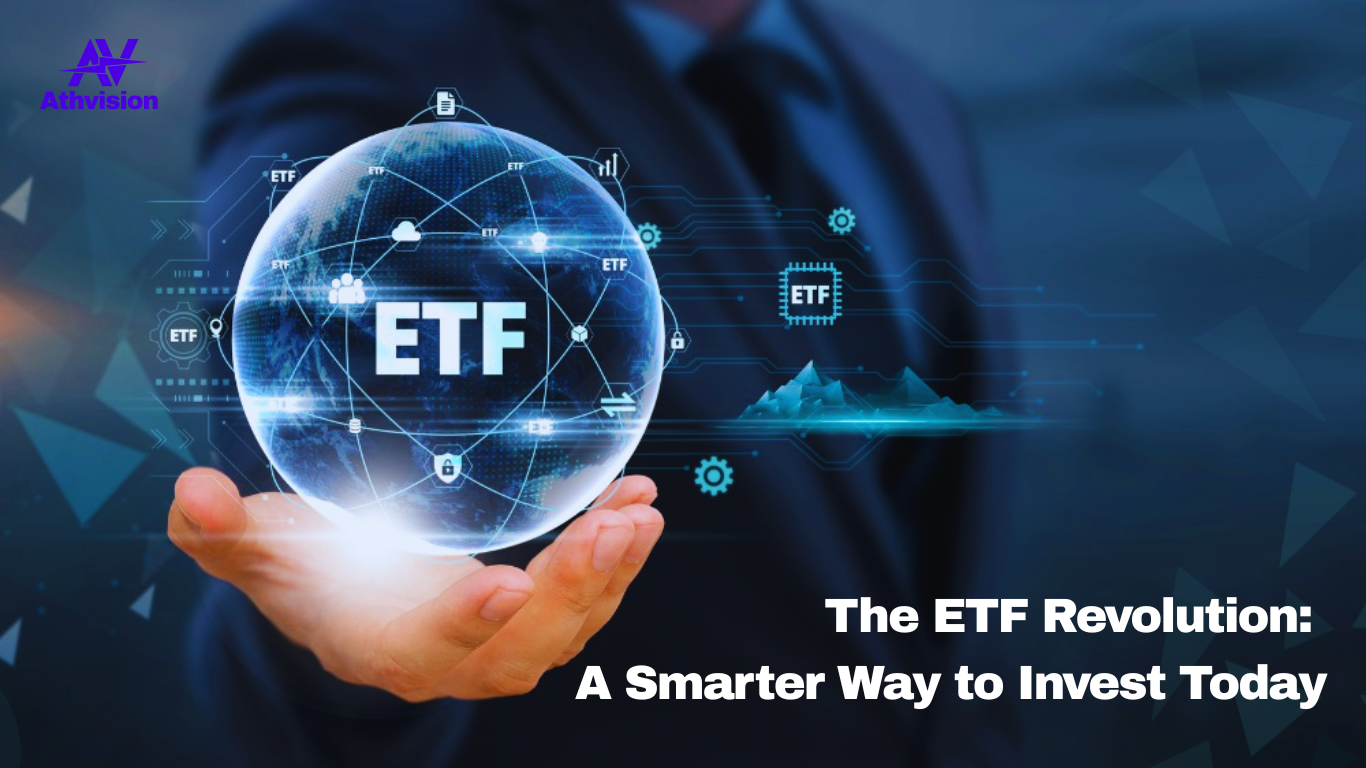The investment landscape is experiencing a profound transformation. Gone are the days when actively managed mutual funds, expensive brokers, and risky stock picks ruled the market. Today, both seasoned professionals and first-time investors are embracing a more efficient, transparent, and flexible alternative: Exchange-Traded Funds (ETFs).
This isn’t just a passing phase , it’s a fundamental shift in wealth-building strategy. As market volatility grows and traditional assets lose their appeal, ETFs have emerged as the smarter, more resilient choice. Backed by trillions in global assets and reshaping how portfolios are built, ETFs are redefining what it means to invest wisely in 2025 and beyond.
What Are ETFs and Why Are They Taking Over?
ETFs are baskets of securities, like stocks, bonds, or commodities, that trade on public exchanges just like individual stocks. What sets them apart is their ability to offer instant diversification, low fees, and real-time tradability, all in one product.
Whether you’re looking to mirror the S&P 500, tap into emerging technologies, or invest in global clean energy, there’s likely an ETF tailored to that interest. And that flexibility is key to why ETFs are becoming the preferred tool for smart investors in 2025.
Global ETF assets under management (AUM) have surpassed $10 trillion, a clear sign of investor confidence and market maturity. As more people gain access to investing through digital platforms and apps, ETFs offer the perfect blend of simplicity and sophistication.
Why Traditional Assets Are Losing Their Shine
For decades, traditional investment vehicles like mutual funds, individual stocks, and fixed-income products such as bonds and CDs dominated the wealth-building strategies of both retail and institutional investors. These options were once considered reliable, tried-and-true paths to financial growth. But the investing landscape has shifted, and today’s smarter, more informed investors are asking a crucial question: Why stick with outdated tools that cost more and deliver less?
Let’s break down why these legacy assets are falling out of favor:
- Mutual Funds: An Expensive Legacy
Mutual funds have long been positioned as a “safe” way to invest in a diversified portfolio. But they come with several hidden disadvantages that many investors are no longer willing to tolerate:
- High Fees and Expense Ratios: Actively managed mutual funds often charge management fees between 1% and 2%, not including sales commissions or other hidden costs. Over time, these fees significantly reduce an investor’s long-term returns.
- No Real-Time Trading: Mutual funds are only priced once a day—at market close. This means investors cannot react in real time to market shifts or adjust positions on the fly, limiting flexibility.
- Lack of Transparency: Many mutual funds do not disclose their holdings on a daily basis, leaving investors in the dark about exactly where their money is going. This opacity undermines trust, especially in volatile markets where transparency is critical.
- Individual Stocks: High Risk, High Maintenance
Owning individual stocks can be exciting and potentially lucrative, but it also exposes investors to a level of risk and workload that many find unsustainable:
- Volatility and Lack of Diversification: Putting a large portion of your portfolio in a few stocks can lead to wild price swings and emotional stress. Diversification is harder to achieve unless you’re managing dozens of positions.
- Time-Intensive Research: Successful stock investing requires continuous analysis, staying updated on earnings reports, industry news, and macroeconomic trends. For busy professionals and casual investors, this level of dedication is simply not feasible.
- Emotional Decision-Making: Stock investing often invites fear-based or greed-driven decisions. Without a disciplined system, many investors fall into classic behavioral traps—buying high and selling low.
- Bonds and Certificates of Deposit (CDs): Outpaced by Inflation
Traditionally used to preserve capital and generate steady income, bonds and CDs are also losing favor, especially in today’s high-inflation environment:
- Low Yields: With interest rates only beginning to normalize, the real returns on bonds and CDs often fail to keep pace with inflation, meaning your money may lose purchasing power over time.
- Limited Liquidity: Traditional bonds and CDs can lock investors in for fixed terms. Selling early may incur penalties or result in losses, unlike bond ETFs which offer daily liquidity.
- Lack of Flexibility: These instruments don’t provide the agility or strategic optionality that many modern investors now demand. Bond ETFs, on the other hand, allow for tactical allocation and real-time access to interest rate trends.
The Smarter Alternative: ETFs
As the complexities of global markets grow, from rising inflation and interest rate swings to geopolitical instability and rapid technological disruption, many investors are reevaluating their traditional strategies. In this environment, Exchange-Traded Funds (ETFs) have emerged as a powerful and pragmatic alternative. They offer the exposure investors crave, whether to stocks, bonds, specific sectors, or emerging themes, without the complications often associated with individual stock picking or actively managed mutual funds. By combining the broad diversification of mutual funds with the real-time tradability and low costs of individual stocks, ETFs present a compelling middle ground for building efficient, risk-adjusted portfolios.
What truly sets ETFs apart is the level of control and clarity they give to investors. With transparent holdings, low management fees, and the ability to trade throughout the day, ETFs allow for agile, informed decision-making. This flexibility is essential in a market where opportunities and risks can shift in real time. Whether you’re a seasoned investor looking to fine-tune your portfolio or a newcomer seeking a balanced entry point, ETFs offer a scalable, intelligent solution. They’re no longer just an alternative, they’re fast becoming the default choice for investors who want to stay ahead in a rapidly evolving financial landscape.
The Most Popular ETFs Among Modern Investors
ETFs have skyrocketed in popularity, not just because they’re affordable and flexible, but because they give investors targeted access to nearly every asset class, sector, and theme imaginable. Today’s investors, especially those who are digitally savvy and financially literate, are moving beyond the classic buy-and-hold strategy. Instead, they’re building highly personalized portfolios using a variety of ETF types to reflect their financial goals, market views, and personal values. Here’s a look at the most dominant ETF categories shaping portfolios in 2025.
- Index ETFs remain the core of most investment strategies. These track major benchmarks such as the S&P 500, NASDAQ-100, Russell 2000, or international indices like the MSCI World Index. They are perfect for long-term, passive investors who value market efficiency and want to keep costs ultra-low, sometimes as little as 0.03% in annual fees. Examples like the Vanguard S&P 500 ETF (VOO) and iShares Core MSCI World (IWDA) are staples in retirement accounts and wealth preservation strategies. Their broad exposure, tax efficiency, and simplicity make them the reliable backbone of most portfolios.
- Thematic ETFs, by contrast, allow investors to focus on specific transformative trends. Whether it’s artificial intelligence, blockchain and Web3, green energy, the metaverse, or even space exploration, these funds let investors align their capital with macro narratives they believe in. They’re especially appealing to those seeking early exposure to disruptive technologies or wanting their investments to reflect their personal values. Thematic ETFs are less about diversification and more about conviction, and while they can be riskier, they provide a way to “vote with your money” in the future.
- Sector ETFs group companies by industry, like technology, healthcare, financials, real estate, or utilities, allowing tactical investors to make macroeconomic bets based on where they think the economy is headed. As sectors rotate in and out of favor depending on market conditions like inflation or interest rates, ETFs make it easy to shift allocations accordingly. This targeted diversification allows investors to capitalize on opportunities without betting on a single stock.
- Smart Beta ETFs offer a hybrid between active and passive strategies. Instead of being weighted by market cap like traditional index funds, these ETFs are built around specific investment factors such as value, momentum, low volatility, quality, or dividend yield. They’re ideal for investors who want to enhance returns or manage risk without the high fees of traditional active management. In many cases, they offer hedge fund-style strategies to retail investors, bringing institutional-level precision to everyday portfolios.
- Bond and International ETFs expand the reach of retail portfolios beyond domestic equities. They include government and corporate bonds, emerging market debt, and global stock exposure. For income-seeking investors or those looking to reduce home-country bias, these ETFs provide liquidity, diversification, and access to global opportunities. In a world where economies are deeply interconnected, having global exposure is not just smart, it’s necessary.
- But what truly sets savvy investors apart is how they use these tools. Strategic ETF usage is where professionals and seasoned retail investors gain the edge. The Core-Satellite Strategy, for instance, involves building a stable foundation with broad market ETFs, then adding higher-risk, high-conviction thematic ETFs as satellites to capture upside. This creates a balance between dependable growth and targeted opportunities.
- Another popular method is Dollar-Cost Averaging (DCA), where investors contribute a fixed amount to ETFs at regular intervals, regardless of market conditions. This strategy smooths out volatility, avoids emotional trading decisions, and encourages disciplined investing over time.
- For those thinking long term, the Buy-and-Hold approach shines. ETFs’ low costs and tax efficiency make them ideal for compounding wealth over decades, with minimal emotional stress and fewer transaction fees. It’s the foundation of retirement planning and long-term capital preservation.
- Finally, Automated ETF Portfolios powered by robo-advisors like Betterment, SoFi, or Wealthfront have democratized smart portfolio management. These platforms use sophisticated algorithms to create and rebalance diversified ETF portfolios based on an investor’s goals, timeline, and risk profile, perfect for beginners or busy professionals who prefer a “set it and forget it” approach.
In all, modern ETF investing is no longer about choosing one fund and walking away. It’s about using a suite of strategic tools to build smarter, more resilient portfolios. Whether you’re passive, tactical, or tech-driven, there’s an ETF, or several, that can help turn your vision into results.
Pitfalls to Avoid: Common ETF Missteps
While Exchange-Traded Funds (ETFs) offer flexibility, low costs, and broad access to the markets, they’re not without risks. Many investors, particularly beginners, make avoidable mistakes that can compromise their returns or even increase their risk exposure unintentionally. Here are some of the most common ETF missteps, and how to avoid them:
- Overlapping Holdings: The Hidden Risk of Over-Diversification
It’s easy to assume that owning more ETFs automatically means better diversification. However, many investors overlook the fact that several ETFs—especially those tracking popular indexes or sectors, often hold the same large-cap stocks such as Apple, Microsoft, or Amazon. This results in unintentional overexposure to just a few companies, creating a false sense of diversification. Rather than spreading risk, you may actually be concentrating it. To avoid this, always examine the top holdings of each ETF before adding it to your portfolio. Tools like ETF.com or Morningstar offer transparent breakdowns. The goal should be true diversification, not duplication.
- Hype-Driven Thematic Investing: The Danger of Chasing Trends
Thematic ETFs based on trending sectors like the metaverse, cannabis, or artificial intelligence can be tempting, offering a compelling story and the allure of future growth. But not all themes are grounded in solid fundamentals. Some ETFs are launched primarily to capitalize on hype rather than based on the actual performance or potential of the underlying companies. These funds can be narrowly focused, hold speculative assets, and carry higher volatility. Before jumping in, take the time to research the fund’s structure, expense ratio, and holdings. Ask yourself if the trend is backed by data and long-term viability, or simply driven by short-term excitement.
- Low Liquidity: Hidden Costs and Price Distortion
Not every ETF is actively traded, and this lack of liquidity can lead to hidden costs. ETFs with low average trading volume often suffer from wider bid-ask spreads, making it more expensive to buy or sell. In times of market volatility, this can result in price slippage or difficulty exiting positions at fair market value. These issues are especially problematic for smaller or niche ETFs. To mitigate this risk, focus on funds with high daily volume, narrow spreads, and at least $100 million in assets under management. These characteristics generally ensure better liquidity and more efficient trading.
- Misused Leverage: Not Built for the Long Haul
Leveraged and inverse ETFs can offer 2x or 3x the daily returns of an index, which sounds attractive, especially in a bull market. However, they are designed for short-term trading and reset their exposure daily. Holding them for extended periods, particularly in volatile markets, can lead to a deterioration in performance due to compounding effects. Many investors mistakenly use these ETFs for long-term bets, unaware of the risks. If you’re considering leveraged ETFs, make sure you fully understand their mechanics and use them only for tactical, short-term strategies. They are better suited for experienced traders than passive investors.
- Thoughtful Approach to ETFs Still Matters
ETFs have undeniably transformed the investing landscape, offering simplicity, cost-efficiency, and access to a wide range of assets. But despite their convenience, they’re not foolproof. Missteps like over-concentration, trend-chasing, low liquidity, or misuse of leverage can undermine your financial goals. Successful ETF investing still requires thoughtful planning, regular portfolio monitoring, and continuous learning. Investors should treat ETFs not as a one-click solution, but as tools that need to be aligned with their broader strategy. Smart choices, backed by research and awareness, are what turn ETF investing from merely easy into truly effective.
The Future of ETFs: Where We’re Headed
Exchange-Traded Funds have already reshaped the investing world, but their transformation is far from over. As technology, regulation, and investor behavior continue to evolve, the ETF space is poised for even greater disruption. Here’s a look at the next wave of ETF innovation that’s changing the game for both retail and institutional investors:
1. AI-Powered ETFs: Smarter Decisions in Real Time
Artificial Intelligence is revolutionizing ETF management by introducing a new level of agility and data-driven precision. Unlike traditional index funds that follow static strategies, AI-powered ETFs continuously analyze real-time market data, sentiment trends, and macroeconomic indicators to adjust their holdings dynamically. This allows them to respond faster to market shifts, buying opportunities or avoiding downturns, potentially improving performance during volatile or uncertain periods. For investors seeking an edge without constant hands-on involvement, AI-powered ETFs offer a smarter, more adaptive way to invest.
2. Crypto ETFs: Regulated Access to Digital Assets
The introduction of cryptocurrency ETFs is a game-changer for both traditional and digital finance. Investors can now gain exposure to assets like Bitcoin and Ethereum through regulated financial products, such as spot Bitcoin ETFs and diversified crypto index funds without needing to manage wallets, keys, or exchanges themselves. This development brings a level of security, transparency, and compliance that was often lacking in the crypto space. By bridging the gap between legacy finance and the Web3 ecosystem, crypto ETFs open the door for more cautious or institutional investors to participate in the digital asset revolution with greater confidence and ease.
3. Fractional ETF Investing: Making Wealth Accessible
The era of needing large sums to start investing is over. Fractional ETF investing now allows individuals to buy portions of ETF shares with as little as $5 or $10, making it easier than ever to begin building wealth. This innovation is particularly impactful for younger investors, those new to the market, or individuals in developing economies where capital is limited. By lowering the entry barrier, fractional investing democratizes access to diversified, low-cost portfolios, empowering more people to take control of their financial futures, regardless of income level.
4. Custom Indexing: Build-Your-Own ETF
Custom indexing is revolutionizing how investors approach portfolio management by allowing them to build a personalized ETF experience, much like curating a Spotify playlist. Rather than relying on traditional prebuilt indexes, investors can now select specific companies, sectors, or themes that align with their financial goals and personal values. Whether it’s excluding fossil fuel stocks or doubling down on clean energy, this approach offers greater control over portfolio structure while still benefiting from the low fees, transparency, and tax efficiency that ETFs are known for. It’s a powerful solution for those who want both customization and simplicity in their investing strategy.
Conclusion: The Future Belongs to ETF-Driven Investors
As we move deeper into an era defined by innovation, agility, and information, the way we invest must evolve too. Exchange-Traded Funds (ETFs) are no longer just a convenient alternative, they’re at the forefront of a global investment revolution. With their unmatched combination of transparency, flexibility, and efficiency, ETFs empower investors to navigate today’s complex financial landscape with greater confidence and control.
What makes ETFs truly powerful is not just their structure, but their adaptability. From AI-driven funds and crypto exposure to thematic plays and fractional investing, ETFs are constantly evolving to reflect the values, trends, and strategies of the modern investor. Whether you’re building wealth slowly over time, responding tactically to market shifts, or aligning your portfolio with personal beliefs, ETFs provide the tools to do so intelligently and effectively.
The traditional investing playbook, burdened by high fees, lack of transparency, and rigid structures is being replaced by a smarter, more democratized approach. And at the center of this shift are ETFs: accessible, responsive, and designed for the investor of today and tomorrow.
In a world where information travels at light speed and markets respond in real time, those who embrace the ETF revolution aren’t just adapting, they’re leading. The future of investing isn’t just digital, diversified, or data-driven. It’s all of the above and ETFs are how we get there.





